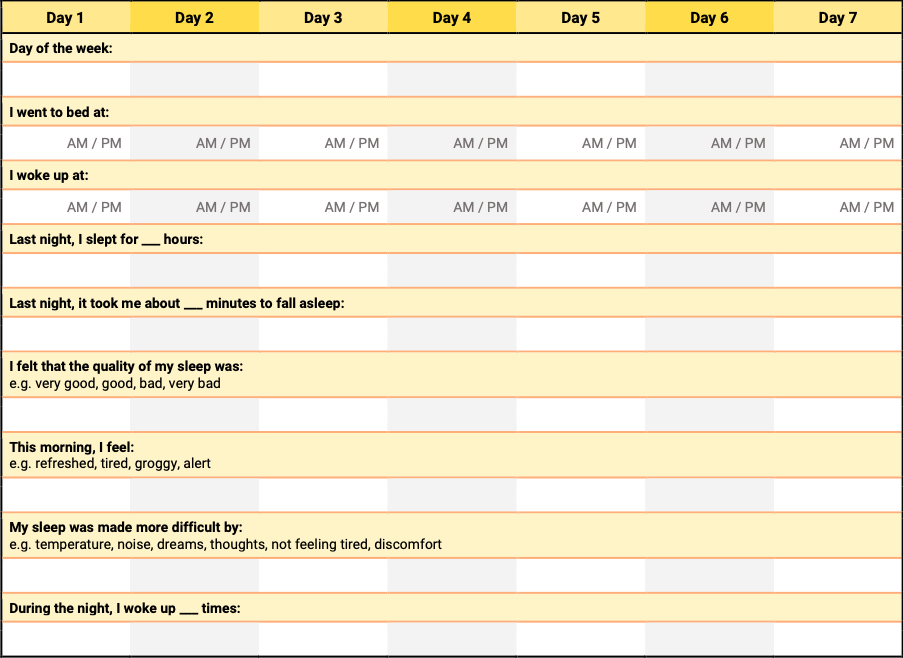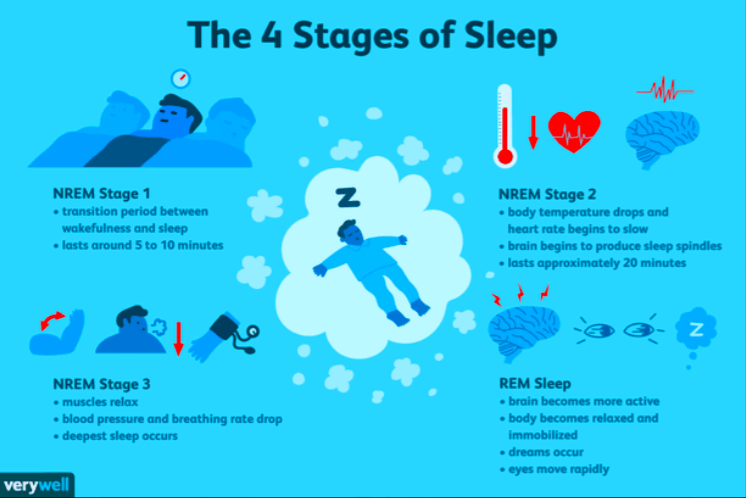By: Shufen Wei, Waikit Tsang
Detail information about this lesson’s design processDownload
Introduction
Many students are struggling with low quality of sleep, or lack of sleep. However sleep is undoubtedly one of the most essential requirements for human body to function properly. The quality and quantity of sleeping will directly affect your mental and physical health. Having poor sleep can lead to many bad consequences. Therefore, we will cover the following areas to help you understand why a good sleep is important and know how to get a good sleep.
First, we will start with *the definition of sleep, *the stages of sleep, and *the amount of sleep time that you need. Then, we will explain *why do we need a good sleep? *what’s the consequence of having poor sleep or lack of sleep. Finally, we will describe the *4 ways that can help you sleep better.
Learning Objectives
By the end of this lesson, you will be able to:
- Define what the sleep is and describe the stages of sleep.
- Know how many hours of sleep are required at different ages.
- Understand why having a good sleep is matter and describe the consequences of having poor sleep
- List 4 ways that can help you get a good night’s sleep.
Pre-class Activity
Before start it, we would like you to create a “sleep diary” about your last night’s sleep. And share it with you group member about how your last night’s sleep went and how you feel this morning.
*Note: A sleep diary is a daily record of how you sleep. It can help you to track your sleep patterns over a period of time; make you more aware of your own sleep habits, and also will be an important complement to your sleep disorder evaluation. (An example of sleep diary is here):

Then, please read the article that attached below and share you thoughts with your group members:
https://www.zmescience.com/science/two-thirds-college-students-lack-sleep-89273553/embed/#?secret=706h52hwYlMicu, A. (2021, November 4). Two-thirds of college students are struggling with lack of sleep, poor sleep quality. ZME Science. https://www.zmescience.com/science/two-thirds-college-students-lack-sleep-89273553/https://www.zmescience.com/science/two-thirds-college-students-lack-sleep-89273553/
What is Sleep?
Sleep is a naturally recurring state of mind and body, characterized by altered consciousness, relatively inhibited sensory activity, reduced muscle activity and inhibition of nearly all voluntary muscles during rapid eye movement (REM) sleep and reduced interactions with surroundings.
Sleep occurs in repeating periods, in which the body alternates between two distinct modes: REM sleep and non-REM sleep.
Stages of Sleep
Sleep has been divided into 4 stages, they are awake sleep (stage 1), light sleep (stage 2), deep sleep (stage 3), and REM sleep (stage 4).Stages 1 to stage 3 are considered as Non-rapid eye movements (NREM). Stage 4 is considered as Rapid eye movement (REM) sleep.
Each stage of sleep plays a different role in maintaining your brain’s cognitive performance and preparing your body for the next day.
(*The detail information is attached below)

Daily Sleep Requirements
For most adults, at least seven hours of sleep is needed for proper cognitive and behavioral functions. Our daily sleep requirements for diferent age groups are listed at below:
Why do we need a good sleep?
According to the National Sleep Foundation (NSF), sleep is essential for a person’s health and wellbeing. Because when you sleep, it’s not just resting your body and brain, the body repairs itself as far as possible (Khan, 2021). If you have poor sleep, it can increase the risk of having poor health, and poor health can make it harder to sleep (Mental Health Foundation). That’s why it’s important to make sure we get a good quality of sleep.
What’s the consequence of having poor sleep?
There are 6 common health problems that can be resulted from having bad sleep, please check the infographic that is attached below.

How to get a good sleep?
https://youtube.com/watch?v=vOlA1ItCzlA%3Ffeature%3Doembed
Post-class homework & Course feedback
You are going to apply one of the strategies that you learned today, and use “Sleep diary” to track your sleep for 7 days. Then, your are going to write a short personal reflection about how you feel after using some strategies that can help you sleep, and considering the benefits of good sleep based on your personal experience. (50%) In the end, you need to complete a class assessment (50%)
[Optional Reading]: Common Sleep Disorders
_________________________________________________________________________
What Learning Theories were Implemented in This Project?
As we know, interactive teaching styles could capture students’ attention and promote student’s participation. Therefore, we hope to create a group discussion which enable every student engage in and contributes their thoughts for the topic. On the other hand, having a multimedia learning environment can promote learning (Mayer, 2014).Therefore, we created multiple multimedia elements, like the video form of powerpoint presentation, infographics, variety screenshots or images and a summative assessment during the process of instructional design.
Based on the learning theory that distributed from Mayer, he states that people can learn more deeply from words and pictures than from words alone (Mayer, 2014, p1). Therefore, we have inserted all relevant images in all media objects that we created. At the same time, we put all the images physically integrated with their text, due to the Principle of Split-attention and Spatial Contiguity
For making an effective presentation, each slide that we created only include one idea. And all the information that shows on powerpoint is about “How to get a good sleep”. That is based on the Cognitive Load Theory. Because our working memory has a limited capacity, So, our instructional methods should avoid overloading information (Mind Tools, n.d.). Meanwhile, in order to maximize student’s learning outcome, we also applied other three learning theories during the design process of powerpoint presentation. First, we use red colour highlighted every information that need to be noticed, this is based on the Signaling Principle. It prevents students miss the important details. Second, we followed the Temporal Contiguity Principle, let the words and animation are presented simultaneously. Finally, a Dual-coding Theory was applied, information was represented by visual and verbal. That’s why we covert regular slide show into video form to help students understand the information better.
Basically during the process of designing the whole lesson, we have keep following the 5 Principles of How to Reducing Extraneous Processing in Multimedia Learning. At the same time, we also applied two instruction approaches, called “Active Learning” and “Assessment” in our instructional design. Like exploring the benefits of good sleep by themselves. Because we did not cover this information in this lesson, and we hope students can deepens their learning by self, instead of hearing from teacher. In the end, having a summative assessments can help students measure their overall learning outcome and effectiveness of instructional design.
References:
Cognitive Load Theory: Making Learning More Effective. (n.d.). Mind Tools. https://www.mindtools.com/pages/article/cognitive-load-theory.htm
Khan, F. (2021, May 25). How Many Hours Of Sleep Do You Really Need? PharmEasy Blog. https://pharmeasy.in/blog/how-many-hours-should-we-sleep/
Mayer, R. E. (Ed.). (2014). The Cambridge Handbook of Multimedia Learning (2nd ed.). Cambridge University Press. https://doi.org/10.1017/CBO9781139547369
Micu, A. (2021, November 4). Two-thirds of college students are struggling with lack of sleep, poor sleep quality. ZME Science. https://www.zmescience.com/science/two-thirds-college-students-lack-sleep-89273553/
The 4 Stages of Sleep (NREM and REM Sleep Cycles). (2021, December 6). Verywell Health. https://www.verywellhealth.com/the-four-stages-of-sleep-2795920
The importance of sleep. (2016, October 14). Mental Health Foundation. https://www.mentalhealth.org.uk/blog/importance-sleep
Recent Comments